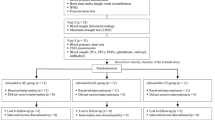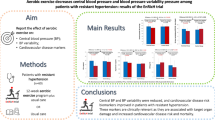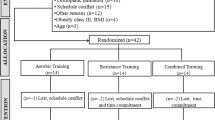Abstract
An exaggerated blood pressure (BP) response to exercise predicts future cardiovascular risk. The mechanisms underlying exercise-induced hypertension remain unclear, although endothelial dysfunction and elevated arterial stiffness may contribute. Given the association between reductions in nitric oxide (NO) and vascular dysfunction, we sought to determine whether acute inhibition of NO synthase with NG-monomethyl-L-arginine (L-NMMA) would lead to exaggerated BP responses to maximal exercise and attenuate exercise-induced reductions in arterial stiffness. In 10 healthy subjects (31±5 years), BP and heart rate (HR) were measured before, during and after an incremental cycling exercise test to determine maximal oxygen consumption (VO2max). Trials were performed with placebo (saline) or intravenous infusion of L-NMMA on separate days in a randomized, double-blind, crossover design. Central (aortic) and peripheral (femoral) arterial stiffness were assessed using pulse wave velocity (PWV). BP was increased with L-NMMA at rest and during sub-maximal exercise, but not at maximal exercise (mean BP 117±5 vs 118±8 mm Hg, saline vs L-NMMA, P>0.05). Furthermore, L-NMMA had no influence on exercising HR or VO2max (P<0.05). Notably, aortic PWV was similarly increased after exercise with either saline or L-NMMA (P<0.05), whereas postexercise decreases in femoral PWV were attenuated with L-NMMA (P<0.05). Our findings suggest that NO is an important contributor to reductions in femoral artery stiffness after maximal exercise in healthy individuals. Furthermore, acute pharmacological inhibition of NO synthase causes augmented BP responses to sub-maximal exercise, but does not lead to exaggerated BP responses to maximal exercise or reduce maximal oxygen consumption.
This is a preview of subscription content, access via your institution
Access options
Subscribe to this journal
Receive 12 digital issues and online access to articles
$119.00 per year
only $9.92 per issue
Buy this article
- Purchase on Springer Link
- Instant access to full article PDF
Prices may be subject to local taxes which are calculated during checkout


Similar content being viewed by others
References
Le VV, Mitiku T, Sungar G, Myers J, Froelicher V . The blood pressure response to dynamic exercise testing: a systematic review. Prog Cardiovasc Dis 2008; 51 (2): 135–160.
Miyai N, Arita M, Morioka I, Miyashita K, Nishio I, Takeda S . Exercise BP response in subjects with high-normal BP: exaggerated blood pressure response to exercise and risk of future hypertension in subjects with high-normal blood pressure. J Am Coll Cardiol 2000; 36 (5): 1626–1631.
Singh JP, Larson MG, Manolio TA, O’Donnell CJ, Lauer M, Evans JC et al. Blood pressure response during treadmill testing as a risk factor for new-onset hypertension. The Framingham heart study. Circulation 1999; 99 (14): 1831–1836.
Kurl S, Laukkanen JA, Rauramaa R, Lakka TA, Sivenius J, Salonen JT . Systolic blood pressure response to exercise stress test and risk of stroke. Stroke 2001; 32 (9): 2036–2041.
Filipovsky J, Ducimetiere P, Safar ME . Prognostic significance of exercise blood pressure and heart rate in middle-aged men. Hypertension 1992; 20 (3): 333–339.
Mundal R, Kjeldsen SE, Sandvik L, Erikssen G, Thaulow E, Erikssen J . Exercise blood pressure predicts mortality from myocardial infarction. Hypertension 1996; 27 (3 Part 1): 324–329.
Kannel WB, McGee D, Gordon T . A general cardiovascular risk profile: the Framingham Study. Am J Cardiol 1976; 38 (1): 46–51.
Nashar K, Nguyen JP, Jesri A, Morrow JD, Egan BM . Angiotensin receptor blockade improves arterial distensibility and reduces exercise-induced pressor responses in obese hypertensive patients with the metabolic syndrome. Am J Hypertens 2004; 17 (6): 477–482.
Laurent S, Cockcroft J, Van Bortel L, Boutouyrie P, Giannattasio C, Hayoz D et al. Expert consensus document on arterial stiffness: methodological issues and clinical applications. Eur Heart J 2006; 27 (21): 2588–2605.
Naka KK, Tweddel AC, Parthimos D, Henderson A, Goodfellow J, Frenneaux MP . Arterial distensibility: acute changes following dynamic exercise in normal subjects. Am J Physiol Heart Circ Physiol 2003; 284 (3): H970–H978.
Kingwell BA, Berry KL, Cameron JD, Jennings GL, Dart AM . Arterial compliance increases after moderate-intensity cycling. Am J Physiol 1997; 273 (5 Part 2): H2186–H2191.
Sugawara J, Otsuki T, Tanabe T, Maeda S, Kuno S, Ajisaka R et al. The effects of low-intensity single-leg exercise on regional arterial stiffness. Jpn J Physiol 2003; 53 (3): 239–241.
Kinlay S, Creager MA, Fukumoto M, Hikita H, Fang JC, Selwyn AP et al. Endothelium-derived nitric oxide regulates arterial elasticity in human arteries in vivo. Hypertension 2001; 38 (5): 1049–1053.
Chang HJ, Chung J, Choi SY, Yoon MH, Hwang GS, Shin JH et al. Endothelial dysfunction in patients with exaggerated blood pressure response during treadmill test. Clin Cardiol 2004; 27 (7): 421–425.
Stewart KJ, Sung J, Silber HA, Fleg JL, Kelemen MD, Turner KL et al. Exaggerated exercise blood pressure is related to impaired endothelial vasodilator function. Am J Hypertens 2004; 17 (4): 314–320.
Tzemos N, Lim PO, Farquharson CAJ, Struthers, MacDonald TM . Dundee step test predicts vascular endothelial dysfunction in subjects with mild to moderate essential hypertension. Circulation 2004; 102 (Supp II): 606.
Wilson MF, Sung BH, Pincomb GA, Lovallo WR . Exaggerated pressure response to exercise in men at risk for systemic hypertension. Am J Cardiol 1990; 66 (7): 731–736.
Kelly RP, Tunin R, Kass DA . Effect of reduced aortic compliance on cardiac efficiency and contractile function of in situ canine left ventricle. Circ Res 1992; 71 (3): 490–502.
Little WC, Cheng CP . Effect of exercise on left ventricular-arterial coupling assessed in the pressure-volume plane. Am J Physiol 1993; 264 (5 Part 2): H1629–H1633.
Casadei B . The emerging role of neuronal nitric oxide synthase in the regulation of myocardial function. Exp Physiol 2006; 91 (6): 943–955.
Paulus WJ, Shah AM . NO and cardiac diastolic function. Cardiovasc Res 1999; 43 (3): 595–606.
Sagach VF, Shimanskaya TV, Sagach VV, Bogomolets AA . Coronary endothelium dysfunction and heart failure. J Heart Fail 1998; 5: 79.
Fortin J, Habenbacher W, Heller A, Hacker A, Grullenberger R, Innerhofer J et al. Non-invasive beat-to-beat cardiac output monitoring by an improved method of transthoracic bioimpedance measurement. Comput Biol Med 2006; 36 (11): 1185–1203.
McEniery CM, Yasmin, Hall IR, Qasem A, Wilkinson IB, Cockcroft JR . Normal vascular aging: differential effects on wave reflection and aortic pulse wave velocity: the Anglo-Cardiff Collaborative Trial (ACCT). J Am Coll Cardiol 2005; 46 (9): 1753–1760.
Lehmann ED, Gosling RG, Parker JR, deSilva T, Taylor MG . A blood pressure independent index of aortic distensibility. Br J Radiol 1993; 66 (782): 126–131.
Safar ME, London GM . Therapeutic studies and arterial stiffness in hypertension: recommendations of the European Society of Hypertension. The Clinical Committee of Arterial Structure and Function. Working Group on Vascular Structure and Function of the European Society of Hypertension. J Hypertens 2000; 18 (11): 1527–1535.
Chen CH, Nevo E, Fetics B, Pak PH, Yin FC, Maughan WL et al. Estimation of central aortic pressure waveform by mathematical transformation of radial tonometry pressure. Validation of generalized transfer function. Circulation 1997; 95 (7): 1827–1836.
Sharman JE, Lim R, Qasem AM, Coombes JS, Burgess MI, Franco J et al. Validation of a generalized transfer function to noninvasively derive central blood pressure during exercise. Hypertension 2006; 47 (6): 1203–1208.
Chemla D, Hebert JL, Coirault C, Zamani K, Suard I, Colin P et al. Total arterial compliance estimated by stroke volume-to-aortic pulse pressure ratio in humans. Am J Physiol 1998; 274 (2 Part 2): H500–H505.
Kelly RP, Ting CT, Yang TM, Liu CP, Maughan WL, Chang MS et al. Effective arterial elastance as index of arterial vascular load in humans. Circulation 1992; 86 (2): 513–521.
Sharman JE, McEniery CM, Campbell R, Pusalkar P, Wilkinson IB, Coombes JS et al. Nitric oxide does not significantly contribute to changes in pulse pressure amplification during light aerobic exercise. Hypertension 2008; 51 (4): 856–861.
Kleber FX, Vietzke G, Wernecke KD, Bauer U, Opitz C, Wensel R et al. Impairment of ventilatory efficiency in heart failure: prognostic impact. Circulation 2000; 101 (24): 2803–2809.
Beaver WL, Wasserman K, Whipp BJ . A new method for detecting anaerobic threshold by gas exchange. J Appl Physiol 1986; 60 (6): 2020–2027.
Howley ET, Bassett Jr DR, Welch HG . Criteria for maximal oxygen uptake: review and commentary. Med Sci Sports Exerc 1995; 27 (9): 1292–1301.
Chang HJ, Chung JH, Choi BJ, Choi TY, Choi SY, Yoon MH et al. Endothelial dysfunction and alteration of nitric oxide/cyclic GMP pathway in patients with exercise-induced hypertension. Yonsei Med J 2003; 44 (6): 1014–1020.
Doshi SN, Naka KK, Payne N, Jones CJ, Ashton M, Lewis MJ et al. Flow-mediated dilatation following wrist and upper arm occlusion in humans: the contribution of nitric oxide. Clin Sci (Lond) 2001; 101 (6): 629–635.
Bech JN, Nielsen CB, Pedersen EB . Effects of systemic NO synthesis inhibition on RPF, GFR, UNa, and vasoactive hormones in healthy humans. Am J Physiol 1996; 270 (5 Part 2): F845–F851.
Liang YL, Gatzka CD, Du XJ, Cameron JD, Kingwell BA, Dart AM . Effects of heart rate on arterial compliance in men. Clin Exp Pharm Physiol 1999; 26 (4): 342–346.
O’Dochartaigh C, Ong H, Lovell S, Donnelly R, Hanratty C, Riley M et al. Changes in pulmonary vascular function after acute methionine loading in normal men. Clin Sci (Lond) 2004; 106 (4): 413–419.
Kruger M, Kotter S, Grutzner A, Lang P, Andresen C, Redfield MM et al. Protein kinase G modulates human myocardial passive stiffness by phosphorylation of the titin springs. Circ Res 2009; 104 (1): 87–94.
Harrison RW, Thakkar RN, Senzaki H, Ekelund UE, Cho E, Kass DA et al. Relative contribution of preload and afterload to the reduction in cardiac output caused by nitric oxide synthase inhibition with L-N(G)-methylarginine hydrochloride. Crit Care Med 2000; 28 (5): 1263–1268.
Prendergast BD, Sagach VF, Shah AM . Basal release of nitric oxide augments the Frank-Starling response in the isolated heart. Circulation 1997; 96 (4): 1320–1329.
Imai K, Sato H, Hori M, Kusuoka H, Ozaki H, Yokoyama H et al. Vagally mediated heart rate recovery after exercise is accelerated in athletes but blunted in patients with chronic heart failure. J Am Coll Cardiol 1994; 24 (6): 1529–1535.
Cole CR, Blackstone EH, Pashkow FJ, Snader CE, Lauer MS . Heart-rate recovery immediately after exercise as a predictor of mortality. N Engl J Med 1999; 341 (18): 1351–1357.
Herring N, Paterson DJ . Neuromodulators of peripheral cardiac sympatho-vagal balance. Exp Physiol 2009; 94 (1): 46–53.
Stamler JS, Loh E, Roddy MA, Currie KE, Creager MA . Nitric oxide regulates basal systemic and pulmonary vascular resistance in healthy humans. Circulation 1994; 89 (5): 2035–2040.
Mayer BX, Mensik C, Krishnaswami S, Derendorf H, Eichler HG, Schmetterer L et al. Pharmacokinetic-pharmacodynamic profile of systemic nitric oxide-synthase inhibition with L-NMMA in humans. Br J Clin Pharmacol 1999; 47 (5): 539–544.
Haynes WG, Noon JP, Walker BR, Webb DJ . L-NMMA increases blood pressure in man. Lancet 1993; 342 (8876): 931–932.
Sugawara J, Maeda S, Otsuki T, Tanabe T, Ajisaka R, Matsuda M . Effects of nitric oxide synthase inhibitor on decrease in peripheral arterial stiffness with acute low-intensity aerobic exercise. Am J Physiol Heart Circ Physiol 2004; 287 (6): H2666–H2669.
Brett SE, Cockcroft JR, Mant TG, Ritter JM, Chowienczyk PJ . Haemodynamic effects of inhibition of nitric oxide synthase and of L-arginine at rest and during exercise. J Hypertens 1998; 16 (4): 429–435.
Dyke CK, Proctor DN, Dietz NM, Joyner MJ . Role of nitric oxide in exercise hyperaemia during prolonged rhythmic handgripping in humans. J Physiol 1995; 488 (Part 1): 259–265.
Sander M, Chavoshan B, Victor RG . A large blood pressure-raising effect of nitric oxide synthase inhibition in humans. Hypertension 1999; 33 (4): 937–942.
Casino PR, Kilcoyne CM, Quyyumi AA, Hoeg JM, Panza JA . The role of nitric oxide in endothelium-dependent vasodilation of hypercholesterolemic patients. Circulation 1993; 88 (6): 2541–2547.
Fisher JP, Young CN, Fadel PJ . Central sympathetic overactivity: maladies and mechanisms. Auton Neurosci 2009; 148 (1-2): 5–15.
Osanai T, Fujita N, Fujiwara N, Nakano T, Takahashi K, Guan W et al. Cross talk of shear-induced production of prostacyclin and nitric oxide in endothelial cells. Am J Physiol Heart Circ Physiol 2000; 278 (1): H233–H238.
Acknowledgements
The time and effort expended by all the volunteer subjects is greatly appreciated. The invaluable clinical support of Drs Leong Lee, Matthias Schmidt, Abdul Maher and Khalid Abozguia is gratefully acknowledged. This research was supported by the British Heart Foundation (to MPF) and the Royal Society (to JPF).
Author information
Authors and Affiliations
Corresponding author
Ethics declarations
Competing interests
The authors declare no conflict of interest.
Rights and permissions
About this article
Cite this article
Campbell, R., Fisher, J., Sharman, J. et al. Contribution of nitric oxide to the blood pressure and arterial responses to exercise in humans. J Hum Hypertens 25, 262–270 (2011). https://doi.org/10.1038/jhh.2010.53
Received:
Revised:
Accepted:
Published:
Issue Date:
DOI: https://doi.org/10.1038/jhh.2010.53
Keywords
This article is cited by
-
Impact of an active lifestyle on cardiovascular autonomic modulation and oxidative stress in males with overweight and parental history of hypertension
Journal of Human Hypertension (2024)
-
The acute effect of passively assisted trunk stretching on central arterial stiffness and blood pressure in middle-aged to older adults
European Journal of Applied Physiology (2024)
-
Safety, efficacy and delivery of isometric resistance training as an adjunct therapy for blood pressure control: a modified Delphi study
Hypertension Research (2022)
-
A systematic review on the effect of acute aerobic exercise on arterial stiffness reveals a differential response in the upper and lower arterial segments
Hypertension Research (2017)
-
Exercise blood pressure: clinical relevance and correct measurement
Journal of Human Hypertension (2015)



